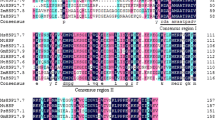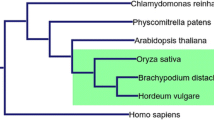Abstract
The universal stress proteins (USPs) play an important role in enhancing survival rate during prolonged exposure to heat shock, nutrient starvation, or stressors from agents that arrest cell growth or damage DNA structures. Searching the HarvEST database of barley resulted in 25 putative USP cDNA sequences. Of these, 16 could translate into intact proteins (putative USPs). The alignments of multiple amino acid sequences between the putative barley USPs with those of Arabidopsis and Methanococcus jannaschii resulted in a set of common residues involved in ATP-binding. The 16 putative USPs in barley and the 21 in Arabidopsis were clustered into seven groups, which were distinct from those of E. coli. The genes in these different groups have different intron/exon structures. Nine putative USP genes of barley were cloned successfully based on their sequence characteristics, and they contain two or three introns each. Two of these introns were present in all the genes, one located between β2 and α2, and the other between β4 and α4. Five sets of primers were successfully developed for these putative USP genes. Two of them were mapped on chromosome 1H and the other three were located on three different chromosomes, 2H, 3H and 6H, respectively. Expression analyses were carried out for nine of these putative USP genes. The expression for two of them was undetectable within 27 h following exposure to salt stress. Six of the other seven were expressed in both root and leaf, and the remaining one was expressed in root only. The majority of these genes was expressed more in the salt-sensitive variety, Morex, than in the more tolerant variety, Steptoe.








Similar content being viewed by others
References
Allex CF (1999) Computational Methods for Fast and Accurate DNA Fragment Assembly. PhD thesis, Department of Computer Sciences, University of Wisconsin, Madison
Aravind L, Anantharaman V, Koonin EV (2002) Monophyly of class I aminoacyl tRNA synthetase, USPA, ETFP, photolyase, and PP-ATPase nucleotide binding domains: implications for protein evolution in the RNA. Proteins 48:1–14
Bilgic H, Steffenson BJ, Hayes PM (2005) Comprehensive genetic analyses reveal differential expression of spot blotch resistance in four populations of barley. Theor Appl Genet 111:1238–1250
Chen FQ, Hayes PM (1989) A comparison of Hordeum bulbosum mediated haploid producion efficiency in barley using in vitro floret and tiller culture. Theor Appl Genet 77:701–704
Francesconi R, Mager M (1979) Heat- and exercise-induced hyperthermia: Effects on high-energy phosphates. Aviat Space Environ Med 50:799–802
Freestone P, Nystrom T, Trinei M, Norris V (1997) The universal stress protein, UspA, of Escherichia coli is phosphorylated in response to stasis. J Mol Biol 274:318–324
Hayes PM, Liu BH, Knapp SJ, Chen F, Blake T, Franckowiak J, Rasmusson D, Sorrells M, Ullrich SE, Wesenberg D, Kleinhofs A (1993) Quantitative trait locus effects and environmental interaction in a sample of North American barley germ plasm. Theor Appl Genet 87:392–401
Kawai Y, Yokoyama Y, Kaidoh M, Ohhashi T (2010) Shear stress-induced ATP-mediated endothelial constitutive nitric oxide synthase expression in human lymphatic endothelial cells. Am J Physiol Cell Physiol 298:647–655
Kerk D, Bulgrien J, Smith DW, Gribskov M (2003) Arabidopsis proteins containing similarity to the universal stress protein domain of bacteria. Plant Physiol 131:1209–1219
Kumar S, Tamura K, Nei M (2004) MEGA3: integrated software for molecular evolutionary genetics analysis and sequence alignment. Brief Bioinform 5:150–163
Kvint K, Nachin L, Diez A, Nystrom T (2003) The bacterial universal stress protein: function and regulation. Curr Opin Microbiol 6:140–145
Lincoln SE, Daly MJ, Lander ES (1993) A Whitehead Institute for Biomedical Research Technical Report Third Edition
Mano Y, Takeda K (1997) Mapping quantitative trait loci for salt tolerance at germination and the seedling stage in barley (Hordeum vulgare L.). Euphytica 94:263–272
McLeod E (1982) Feed the soil. Organic Agriculture Research Institute, Graton
Mesfina A, Smitha KP, Dill-Mackyb R, Evansb CK, Waughc R, Gustusa CD, Muehlbauer GJ (2003) Quantitative trait loci for fusarium head blight resistance in barley detected in a two-rowed by six-rowed population. Crop Sci 43:307–318
Muir CE, Nilan RA (1973) Registration of Steptoe barley. Crop Sci 13:770
Nachin L, Nannmark U, Nystrom T (2005) Differential roles of the universal stress proteins of Escherichia coli in oxidative stress resistance, adhesion, and motility. J Bacteriol 187:6265–6272
Nandigama R, Padmasekar M, Wartenberg M, Sauer H (2006) Feed Forward Cycle of Hypotonic stress-induced ATP release, purinergic receptor activation, and growth stimulation of prostate cancer cells. J Biol Chem 281:5686–5693
Nystrom T, Neidhardt FC (1993) Isolation and properties of a mutant of Escherichia coli with an insertional inactivation of the uspA gene, which encodes a universal stress protein. J Bacteriol 175:3949–3956
Rasmusson DC, Wilcoxson RW (1979) Registration of Morex barley. Crop Sci 19:293
Sambrook J, Fritsch EF, Maniatis T (1989) Molecular cloning: a laboratory manual. Cold Spring Harbor Laboratory Press, New York
Shi YL (2004) Study on desertification and water-land resource in westnorth area. Science Press, Beijing
Sousa MC, McKey DB (2001) Structure of the universal stress protein of Haemophilus influenzae. Structure 9:1135–1141
Tao H, Bausch C, Richmond C, Blattner FR, Conway T (1999) Functional genomics: expression analysis of Escherichia coli growing on minimal and rich media. J Bacteriol 181:6425–6440
Tezara W, Mitchell VJ, Driscoll SD, Lawlor DW (1999) Water stress inhibits plant photosynthesis by decreasing coupling factor and ATP. Nature 401:914–917
Thatcher LF, Manners JM, Kazan K (2009) Fusarium oxysporum hijacks COI1-mediated jasmonate signaling to promote disease development in Arabidopsis. Plant J 58:927–939
Trefil J (1992) 1001 Things everyone should know about science. Doubleday, New York
Van Bogelen RA, Hutton ME, Neidhardt FC (1990) Gene-protein database of Escherichia coli K-12: EDITION 3. Electrophoresis 11:1131–1166
Walia H, Wilson C, Condamine P, Ismail AM, Xu J, Cui XP, Close TJ (2007) Array-based genotyping and expression analysis of barley cv Maythorpe and Golden Promise. BMC Genomics 8:87–100
Wang S, Basten CJ, Zeng ZB (2007) Windows QTL Cartographer 2.5. Department of Statistics, North Carolina State University, Raleigh, NC (http://statgen.ncsu.edu/qtlcart/WQTLCart.htm)
Zarembinski TI, Hung LW, Mueller Dieckmann HJ, Kim KK, Yokota H, Kim R, Kim SH (1998) Structure-based assignment of the biochemical function of a hypothetical protein: a test case of structural genomics. Proc Natl Acad Sci USA 95:15189–15193
Zhang X, Wu XQ, Lu S, Guo YL, Ma X (2006) Deficit of mitochondria-derived ATP during oxidative stress impairs mouse MII oocyte spind. Cell Res 16:841–850
Acknowledgments
We are grateful to Dr. Patrick Hayes (Oregon State University) and Dr. Kazuhiro Sato (Okayama University) for providing the seed samples of Steptoe/Morex DH lines used in this study. The authors also thank the anonymous reviewers for their constructive suggestions. This work was supported by the 973 program (2010CB134400) and China Transgenic Research Program (2008ZX08002-005).
Author information
Authors and Affiliations
Corresponding author
Additional information
Communicated by T. Close.
W.-T. Li and Y.-M. Wei contributed equally.
Rights and permissions
About this article
Cite this article
Li, WT., Wei, YM., Wang, JR. et al. Identification, localization, and characterization of putative USP genes in barley. Theor Appl Genet 121, 907–917 (2010). https://doi.org/10.1007/s00122-010-1359-9
Received:
Accepted:
Published:
Issue Date:
DOI: https://doi.org/10.1007/s00122-010-1359-9




